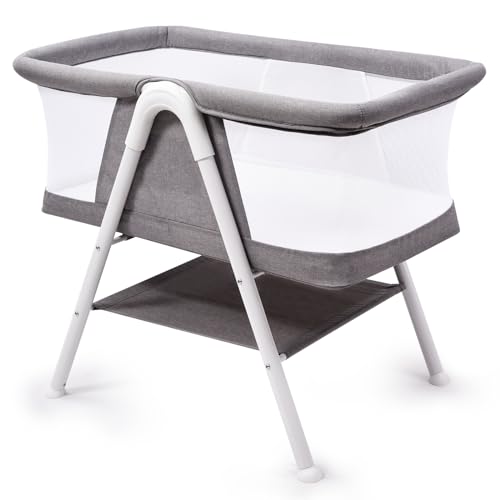The Modern Bedside Cot: A Comprehensive Guide to Bedside Cots That Attach to Beds
In today's busy world, parenting has progressed substantially, with the focus on developing a safe and comfortable environment for infants and young children. Among the notable improvements in this world is the bedside cot, a versatile solution that parents can use to keep their newborns close, specifically throughout the vital early months. This article explores the advantages, features, and factors to consider of employing a bedside cot that connects to a bed.
What is a Bedside Cot?
A bedside cot, typically referred to as a co-sleeper or sidecar crib, is a specially created crib that links to a parent's bed, providing an available sleeping space for infants. Bedside Cot For Stylish Sleep Space offer the convenience of co-sleeping while maintaining a separate sleeping environment for the child.
Key Features of Bedside Cots
- Security Standards: Bedside cots are developed to adhere to high safety requirements, guaranteeing that there are no gaps between the cot and the parent's bed, hence minimizing the danger of entrapment.
- Adjustable Height: Most bedside cots feature adjustable height settings, enabling them to align completely with the parents' bed mattress.
- Convenience: Having the baby within arm's reach can assist with nighttime feedings and reassuring, decreasing the requirement for parents to totally wake up.
- Portability: Many designs are lightweight and quickly collapsible, making them ideal for travel or for families with restricted space.
Benefits of Using a Bedside Cot
The bedside cot provides multiple benefits, including:
- Enhanced Bonding: The close proximity promotes psychological bonding and security for both the baby and the moms and dad.
- Ease of Feeding: Breastfeeding moms can easily access their babies for nighttime feeds without needing to get out of bed.
- Promotes Safe Sleep: Parents can monitor their child's sleeping patterns and breathing closely, reducing anxiety.
- Convenient Access: Parents can quickly and quickly relieve or participate in to their baby without totally getting up.
Picking the Right Bedside Cot
With numerous choices readily available in the market, it is essential to think about numerous factors when selecting a bedside cot:
1. Security Features
Always look for safety certifications, consisting of compliance with relevant requirements. Make sure the cot has features such as:
- Sturdy frame
- Anti-tipping design
- Protected attachment mechanism
2. Product and Construction
The material must be non-toxic and safe for infants. Select cots made from natural wood or premium certified materials. Also, check that the mattress is firm and fits snugly within the cot to prevent any risks.
3. Size and Compatibility
Think about the size of your bed and the readily available space in your bed room. Bedside cots are available in various sizes, so make certain to select one that fits comfortably together with your bed without blocking motion.
4. Mobility
If you prepare to move the cot frequently, try to find light-weight options with wheels or collapsible styles for easy transport.
Popular Bedside Cots on the Market
| Bedside Cot Model | Key Features | Cost Range |
|---|---|---|
| Chicco Next2Me | Adjustable height, breathability mesh, foldable. | ₤ 200 - ₤ 250 |
| BabyBjörn Cradle | Light-weight, natural materials, easy to move. | ₤ 299 - ₤ 349 |
| Arm's Reach Concept 2 | Easy to attach/detach, safety strap, bed mattress included. | ₤ 150 - ₤ 200 |
| Dream On Me Co-Sleeper | Light-weight, portable, various color options. | ₤ 150 - ₤ 180 |
Regularly Asked Questions (FAQs)
1. Is a bedside cot safe for my baby?
Yes, as long as it fulfills security standards and is utilized correctly. Always ensure the cot is securely connected to your bed with no gaps.
2. At what age can my baby use a bedside cot?
Most bedside cots are ideal from birth up until the child can sit up individually or when they start to move around, normally around 5-6 months.
3. Can I use a regular crib as a bedside cot?
Requirement cribs, while roomy, are not created to connect to beds and frequently lack the security features that bedside cots supply. It is best to use a cot particularly created for this function.
4. How do I clean up a bedside cot?
The majority of designs have detachable, washable fabric covers, while wooden frames can be cleaned down with a damp cloth and moderate soap.
5. Exist any downsides to using a bedside cot?
While they are convenient, they might not appropriate for all families. Some parents might discover they choose a different crib for assurance or if their infant has sleep disturbances.
Bedside cots that connect to beds supply a special and convenient option for modern parents wishing to keep their infants close during the night. They open doors to safer co-sleeping choices, motivate bonding, and simplify nighttime routines. With the variety of models readily available, parents must carefully consider their individual requirements and preferences, along with security functions and ease of use, to select the ideal bedside cot. As parenting continues to evolve, bedside cots represent a harmonious blend of tradition and development in fostering a nurturing environment for new households.

